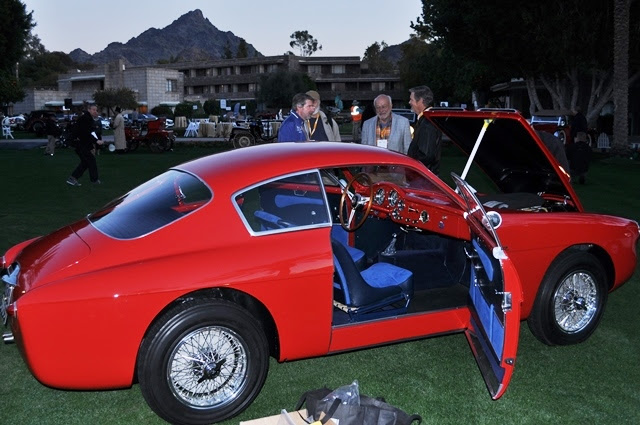 |
| This is an Alfa Romeo 1900C SS. Fantasyjunction.com. |
 |
| . . . and so is this! |
An argument in favor of the latter is that it is so much more descriptive, including the name of the manufacturer, the general model type, the general engine type, the fact that the chassis is shortened, and that the engine is souped up. The argument for the former is that the oh-so-descriptive technical name is not actually as accurate as you might assume.
 |
| Ford Thunderbird. boldride.com. |
Zagato bodied about 40 of them.
But there is only one "Alfatross".
 |
| Pontiac Sunbird. car.mitula.us. |
Birds and Cars
The whimsical naming of automobile models after different types of birds is an idea that has been around a long time. Manufacturers hope that the name they give a particular model will convey something appropriate about the car . . . or at least make it attractive to buyers.
"Thunderbird" conjures up the image of a powerful, attention-getting vehicle.
"Roadrunner" is obviously not a sedate sedan. It captures the essence of Route 66.
"Talon" suggests something aggressive, a bird of prey.
At the other end of the spectrum is the friendly "Bluebird", often associated with happiness. "Sunbird" is more middle-of-the-road, a compromise, but invokes the image of wind-in-your-hair and sun on your face.
The three-wheeled Reliant "Robin" seems appropriately named, making no pretensions to power, speed, handling, style, or . . . anything else.
 |
| Ford Falcon. |
 |
| American Motors Eagle. blog.nwautos.com. |
And then there are the complete misnomers: the Ford Falcon was certainly a disappointment in the areas that the bird species is noted for: high speed and maneuverability.
Aston Martin's diminutive "Cygnet" bore no resemblance whatsoever to a young swan, other than being white.
Unlike its avian namesake, the American Motors "Eagle" was not large and impressive or particularly noteworthy.
 |
| Stutz Blackhawk, first generation. SimeoneMuseum.org. |
 |
| Stutz Blackhawk second generation. camerachemist.wordpress.com |
And the Point Is . . .
Which brings us back to "The Alfatross". Recently, a reader of this blog wrote to suggest that it might be time to drop the name "Alfatross" on the grounds that it is no longer appropriate now that the car is largely restored to its original glory. This post is about why I beg to differ.For those readers who don't get his complaint, he is referring to the belief among seafarers that killing an albatross brings enormous misfortune. This superstition would have disappeared long ago were it not for the epic poem by Samuel Taylor Coleridge, Rime of the Ancient Mariner (see what a college education can do for you?). Obviously, The Alfatross' name is a joke on several levels, and at the same time completely appropriate. From the moment when my friend KC Wordsmith first uttered the phrase "It's your Albatross!" I realized the perfection of the name.
 In the first place, "albatross" is one of the most recognizable of all bird names, and perfect for an awe-inspiring, rare and beautiful car designed to cover long distances with seeming effortlessness. Not surprisingly, the name has been used by at least three erstwhile car manufacturers: the French "Albatros" (1912-12), the English "Albatros" (1922-24), and the American Albatross (1939-39). Disappointingly, association with the albatross did little to promote the success of these companies, each of which went the way of the "Dodo".
In the first place, "albatross" is one of the most recognizable of all bird names, and perfect for an awe-inspiring, rare and beautiful car designed to cover long distances with seeming effortlessness. Not surprisingly, the name has been used by at least three erstwhile car manufacturers: the French "Albatros" (1912-12), the English "Albatros" (1922-24), and the American Albatross (1939-39). Disappointingly, association with the albatross did little to promote the success of these companies, each of which went the way of the "Dodo". And that's not all: The inventors of the first human-powered aircraft to cross the English Channel called it the "Gossamer Albatross" for obvious reasons. In 1968 the rock band Fleetwood Mac released the hauntingly beautiful "Albatross", said to be one of the greatest instrumental tracks of all time.
Other birds may flit about cheerfully, sing enchantingly, dive daringly, or swoop menacingly, but only the albatross soars serenely over the oceans of the world for thousands of miles, returning to earth only to mate and raise its young (some species mate for life). Combining mystique with majesty, it has the longest wing span of any living bird--11 feet or more- and for such a large bird, a supernaturally long lifespan--50 years.
So the name is appropriate. In the Rime of the Ancient Mariner I can relate to the ancient mariner who killed the albatross, and to the car as the albatross. It died 47 years ago and I've wore it around my neck ever since as a kind of penance, but little by little I came to see the seemingly insurmountable difficulties of its restoration as revitalizing challenges to embrace. The writhing mass of brake lines under the transmission used to dismay me but now I see their innate beauty and harmony.
After 47 years of its stewardship The Alfatross will always be The Alfatross to me.












